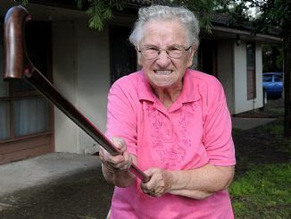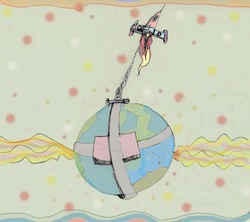
He weighed over 130 pounds, despite weighing in at less than 106 lbs the day before.
He easily outsized his opponent by 20 lbs, maybe 25 lbs. There was no way he was going to lose that match, no way he would be denied a place in state...
but also no chance he would make weight again.
He didn't need to, he just defaulted out...still earning his place in state while denying a youngster who actually weighed his weight class, any chance at all of it.
One might ask, “this is equity?" In a sport defined by weight classes, how can one explain such an enormous differential in weight?
And while equity is a fair question, a better question is: this is safe?
Is this truly how we protect the safety of our young men and occasional women who choose to compete?
I worry about the safety of the natural 106 lber.
I also worry about the safety of that young man who cut so much weight that he regained over 25 lbs in such a short time.
What's more disturbing than an athlete cutting dangerous amounts of weight?
Wall of Denial
Every time I read an article touting the 'safety' of the sport…how the new rules have protected athletes from dangerous weight reduction, have made for 'happier wrestlers wrestling at their natural weight', it makes me want to puke because its such a lie.
Nothing could be further from the truth.
As a trainer of athletes I do everything in my power to help guide the young men who train with me…
guide them to safely reduce their weight and stay healthy…
but it is increasingly more difficult when the kids who 'do it right', go through alpha testing and follow the spirit of the rule, get punished at the end of the year…up a weight class from where they should be, getting beaten by much bigger athletes and by a system that encourages drastic weight reduction at the most crucial times of the year.
Had a guy who trains with me who wrestled 120. Barely missed out on certifying for 113. Got to state and was the smallest 120 I saw…by far.
The system is definitely rigged against the folks wanting to follow the rules.
-Roy (wrestling coach in Ohio)
The governing bodies are to blame.
Listen to me and listen carefully…
The governing bodies are to blame. The alpha system is a tool designed to 'keep athletes safe' but it does the opposite.
Athletes are losing large amounts of weight early in the season to make alpha certification at the weight they want to go…
crashing back down to weight for the most important events of the year, sectional, district and state (here in Ohio), because the rules allow for weigh-outs…meaning, gain as much weight as you can overnight and the next day. Be as big as possible for finals because it is to your advantage….and to the detriment of the 'wrestle your natural weight' athlete.
That cliff is looming ever larger
Folks, we're playing a dangerous game and its not going to end well. We are asking for catastrophe to strike, ala 1997 all over again.
In 1997, 3 college wrestlers died while cutting weight. Drastic rules changes came into place but before they did, a lot of hand-wringing…
a lot of administrators taking a long hard look at our sport and deciding whether it was worth it to field a team.
Very negative documentaries airing over major networks, demonizing our sport.
News outlets went from ignoring wrestling to flooding the airwaves with negativity about wrestling, and lots of it.
If you think tragedy can't strike again, look at these factors and tell me you're convinced our athletes are safe and nothing bad is ever going to happen to any of them…
- large amounts of weight reduction in short amounts of time
- enormous weight gains (the model is already out there – its what many MMA stars do)
- little supervision when reducing for alpha early in the season
- scary levels of dehydration going on to make weight
…and worse…
a general attitude among many wrestlers that ‘this is what you have to do in order to win’.
Just recently, one of my athletes said this to me:
I really believe that losing a bunch of weight all at once is the way to go. No sense cutting all week and being miserable. Plus, you’re bigger than your opponents if you can gain it all back quickly.
Side note: the athlete who told me this failed to make weight his next time on the scales.
Want to fix the problem?
Start with the Alpha testing. Kill it off before it kills us. Not only does it encourage massive weight cutting early in the season, before athletes are in shape, there is also widespread cheating and, at the very least, bending of the rules. This method is not determining a safe weight for athletes to wrestle at.
It is simply in place to allow governing bodies to say, “see, we did our job, its not our fault." But it is and they should bear the brunt of the blame.
Next, insist on same-day weigh-ins…every time. Weigh in no later than 1 1/2 hours before you wrestle. If you can compete, you’re good to go. It is very tough to gain back a ton of weight when you have to wrestle an hour later.
advantage, natural-weight-class wrestler.
do this and watch the state crown some natural-weight-class state champs.
instead of the current champs…106 lbers weighing 125 lbs by finals.
We need to act now instead of later
The thought of a wrestler dying cutting weight is tragic and horrible.
It was tragic and horrible when it happened for real in 1997, too, when 3 college wrestlers lost their lives in a 6 week period of time.
Powers that be, please don’t be arrogant enough to think it can’t happen again. The way we’re going, the extremes that athletes are taking to make their weight, makes this a very real possibility.
At risk are our youngsters we are supposed to be protecting.
We are failing in that regard. If we don’t act now, I fear for the worst…an unspeakable tragedy that we will never recover from.







